Throne of Blood is generally regarded as one of Akira Kurosawa’s coldest Samurai movies. There is none of the roguish good humour of The Hidden Forest, the elegiac humanism of Seven Samurai, the amused cynicism of Yojimbo or the light-hearted fun of Sanjuro. Throne of Blood is a study of evil, and there are no wholly identifiable characters here.
Kurosawa uses a number of methods to detach the viewer from the emotional pull of the story. He employs few camera close-ups, concentrating on the composition of an entire scene instead. We are literally distanced from the characters. There is the pageantry of a funeral procession and battles. In domestic scenes, the camera points face-on at the characters but they are typically not close to the camera, and do not look into it.
Exterior settings are wet or misty. The weather often plays a part in establishing the mood in a Kurosawa film. Here the castle exterior is a set created on Mount Fuji. Appropriately enough, given the precarious position of all the major characters, it is located on a cliff edge. It is constantly viewed through the fog.
The mist envelopes everything in Throne of Blood, both castle and surrounding forest. The action takes place in Cobweb Castle and Cobweb Forest, and the names are important. The thick layers of fog give the impression that the characters are lost in a dense cloud of unknowing (figuratively and sometimes literally). The mist also creates the impression of characters trapped in a spider’s lair. Only there are a number of spiders all spinning their own threads and threatening to swallow up any number of victims.
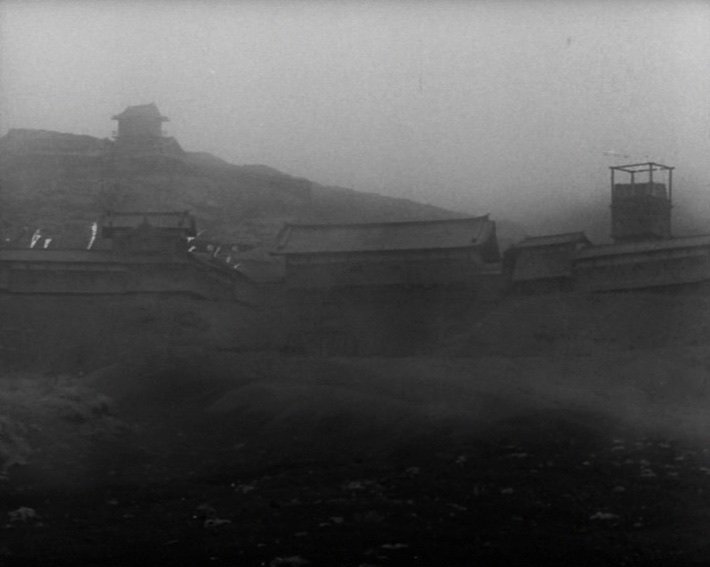
The action is not entirely set outdoors. The indoors settings also add to the claustrophobic and intense ambience of the film. The courtyard and rooms were created in a film studio. Walls and armour are painted in dark colours. The rooms are wide and seemingly spacious, but the ceilings are artificially low to create a cramped effect.
Presentation of the action is stylised, and not naturalistic. Actors often rasp and scream their lines hysterically. The film begins and ends with a chorus describing and commenting on the plot. There is no concession to western influences in the choice of music score, which largely comprises a shakuhachi (bamboo flute) and drums.
Kurosawa also drew heavily on the influence of Noh drama to give the film an artificial feel. This is reflected in the body movements of the characters, the use of masks, the set design, the make-up worn by the female characters, and the general theme of impermanence.
While Throne of Blood is seemingly one of Kurosawa’s most Japanese films, it nonetheless has its inspiration in an Occidental text. Shakespeare was banned from wartime Japan for being too western, but the war was over and the old regime gone. Kurosawa took advantage of the new freedoms to make a number of movies based on Shakespeare’s tragedies. The Bad Sleep Well offered a modern update of Hamlet. King Lear provided the basis for Ran.
In the case of Throne of Blood, Kurosawa drew on Macbeth. Some critics describe Throne of Blood as the best movie adaptation of Macbeth. This is misleading. While Kurosawa infuses his story with the same themes and basic storyline as Shakespeare’s play, it is not an adaptation so much as a reimagining. He sets the action in medieval Japan, and he removes all of Shakespeare’s dialogue in favour of a plainer and more perfunctory script. The poetry of Shakespeare’s words are missing, and they are replaced by the poetry of Kurosawa’s great visuals instead.
Kurosawa saw parallels between the situation in post-war Japan and the problems faced in both medieval Japan and medieval Scotland. In all three instances, power was devolving into the hands of ruthless figures who were driven by ambition to amoral lengths.
The world of Throne of Blood is cyclical. It opens with Lord Tsuzuki (Takamaru Sasaki) being threatened by a rival who is seeking to usurp his position as lord of Cobweb Castle. He is saved by the efforts of his two generals, Washizu (Toshiro Mifune) and Miki (Akira Kubo). However the lord’s need to rely on mighty generals to maintain his position leads to those soldiers becoming too powerful and seeking his position for themselves, and so the cycle goes on.
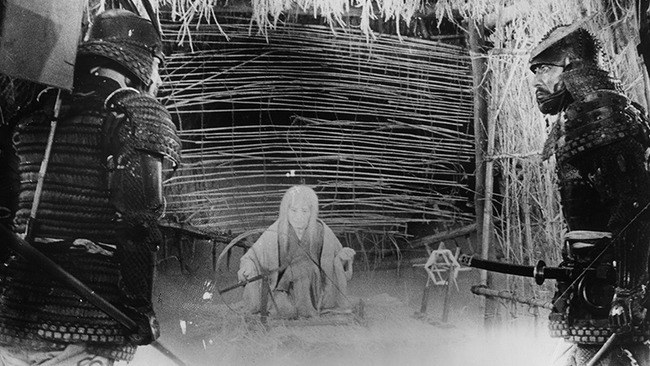
The ambitions of Washizu and Miki are inflamed when they meet an evil spirit (Chieko Naniwa) in Cobweb Forest while riding home from battle. An eerie unworldly atmosphere pervades the scene. The two generals are lost in the fog, even though they know the forest well, and a thunder storm breaks out. They hear a hysterical cackle, and eventually stumble upon the spirit.
She is unnaturally white, as if bleached, both in hair and skin. She is spinning a wheel that apparently comprises the life threads on which ambition is spun. The parallels with a spider spinning a web are clear enough. If the men were not ambitious themselves, they would recognise the ominous tinge to her words:
Men are vain mortals; life is but a thread
A leash, at which men strain and yelp
A stalk on which ambition blooms and withers
Mortal words and deeds are merely lust and greed
But all men one day face the reckoning
Victor and vanquished, saint and sinner
All pay their dues and fade to nothingness.
However this is an evil spirit who is telling them what they want to hear. She foretells that Washizu will become the master of Cobweb Castle, and that Miki’s son will later succeed him.
Are the characters in Throne of Blood mere pawns of fate? Perhaps. There are genuinely supernatural elements here. The witch is seen by more than one person, and her prophecies, even the more unusual ones, come true. The men’s fates are seemingly predestined. There are later portents of fate. The site of Miki’s ghost might be put down to the disturbed mind of Washizu, but what are we to make of Miki’s horse turning wild at the time when the plot on his life draws near, or the birds flying away from Washizu’s castle when his own end is in sight?
Still the characters are manipulated by their own greed, ambition and fears as much as by supernatural forces. The spirit’s prophecies are deliberately designed to make the events happen, and to thoroughly corrupt those who believe them, but only by appealing to the darkness that is already in their souls.
Washizu has designs on Cobweb Castle from the beginning, and the knowledge that he will one day succeed his lord serves to hasten his violent plans. The prophecy concerning Miki’s son further undermines Washizu’s moral character. He becomes paranoid about Miki’s loyalty, and conspires against the life of his former friend.
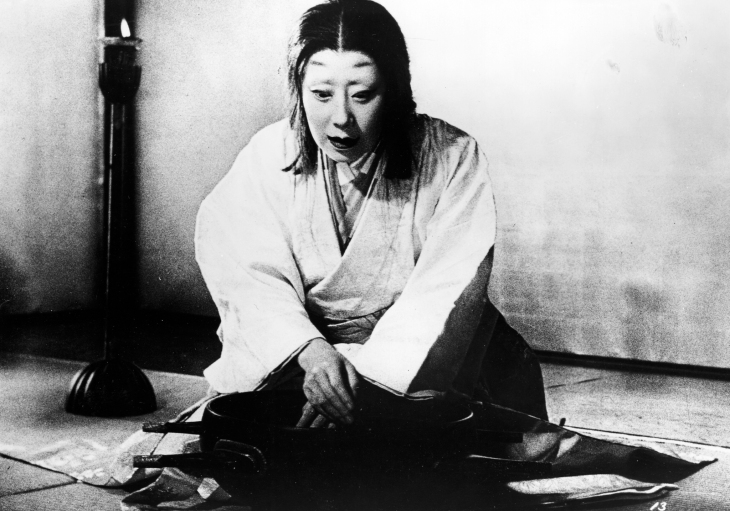
Washizu’s wife also incites the general to murder. Asaji (Isuzu Yamada) seems closely identified with the spirit. She too has a pale and deathly pallor, and a physical appearance taken from Noh theatre. She seems like a tempting voice in Washizu’s ear. She speak very quietly, sits very still and rarely makes eye contact with her husband. She firms up his plans by spreading doubts and fears in his mind.
Indeed Washizu is a victim of his own success. In rising so high, he has become a danger to his own Lord, and he now lives in constant fear that his Lord will seek to destroy a potential rival. The only way out of this is for him to strike first. It is revealed that Lord Tsuzuki similarly killed his own master to preserve his own life.
So Washizu and Asaji kill Lord Tsuzuki and seize power. The Lord’s wife kills herself, just as Asaji will suffer a death of her mind later. Then Washizu fears Miki and his son will do the same to him, and he arranges for their murder without complete success. Admittedly Washizu promised to give the castle to Miki’s son on his death, but this is changed by the discovery that the childless Asaji is pregnant. He now wants the castle for his own son.
However there is no happiness to be gained from power. Asaji’s child is stillborn, making Washizu’s hopes barren and fruitless. He Asaji goes insane. Washizu has lost both friend and wife, and is left with nothing but his insane lust to hold onto power which further corrupts his nature.
This can only lead to more bloodshed, and the blood cannot be removed. The bloodstains of Lord Tsuzuki’s original enemy cannot be washed out of the walls of the castle, and Asaji cannot clean the blood of Lord Tsuzuki from her hands, at least in her insane imaginings. Once the cycle of violence has started, it is impossible for Washizu to turn back.
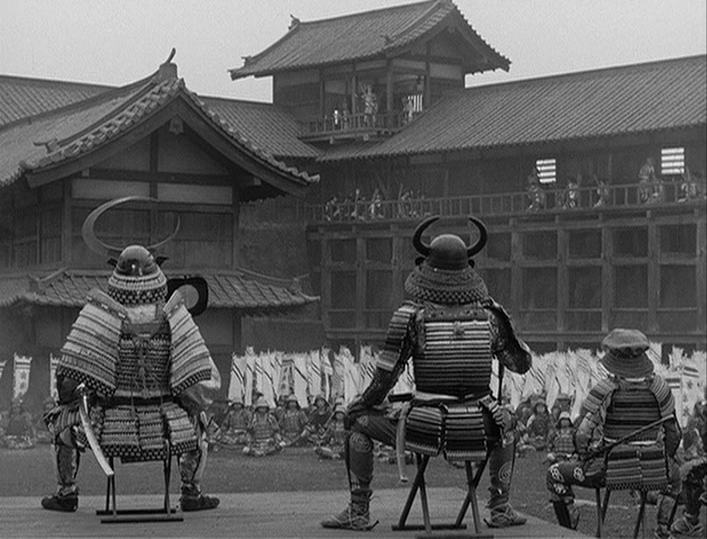
As Washizu’s men begin to desert him for a new rival, the beleaguered leader once more seeks out the spirit. However she again offers him advice intended to make him more depraved and cruel. She reassures him that he will not lose power until Cobweb Forest moves, and comes to Cobweb Castle. The prophecy seeks to reassure Washizu that he will survive, but only if he is utterly ruthless:
If you choose the path of bloodshed, then climb to the pinnacle of evil! If you choose to build a mountain of corpses, build its summit as high as you dare! If you will make blood flow, let it be a river – no, an ocean of blood!
Washizu is happy to accept this evil pact, because he has lost touch with his humanity and any sympathetic contact with other people. Only power is important to him now, and he will preserve it at all costs. However the prophecy has misled him. The enemy soldiers take the boughs of wood from Cobweb Forest and hold them up in front of them. The forest does indeed come to the castle.
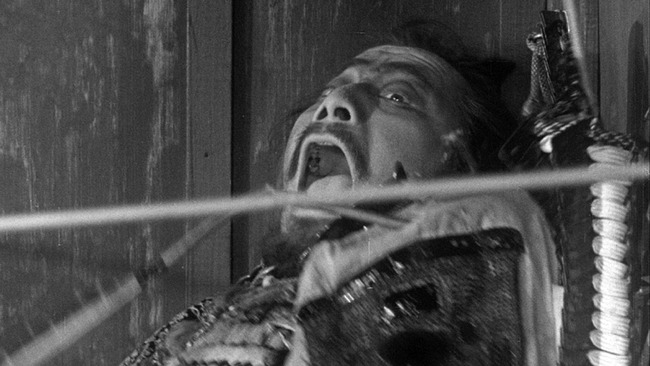
In response, Washizu’s own frightened troops turn on him. This leads to the most remarkable and horrific ending to any of Kurosawa’s movies. The archers fire a volley of arrows at Washizu, and we watch him fleeing from side to side, desperately trying to avoid the lethal missiles. Each time he moves, the arrows form a wall that prevents him from running further. Finally he is transfixed like a porcupine and dies.
The scene was a risky one for Toshiro Mifune to film, as real arrows were employed, so the look of fear on Mifune’s face is probably genuine. To avoid being hit, Mifune waved an arm to indicate in which direction he was about to move. The only arrows that do hit him are fake bamboo ones that were moved on wires.
So Washizu’s reign of terror ends, and it is only the horrific nature of his death that briefly causes us to feel pity for him. However, unlike Shakespeare’s play there is no strong Malcolm figure to restore order at the end. We see only the devastation. The action is once more lost in the all-consuming mist, and it seems likely that the cycle of violence, usurpation and blood will continue as before.

One thought on “Throne of Blood (1957)”